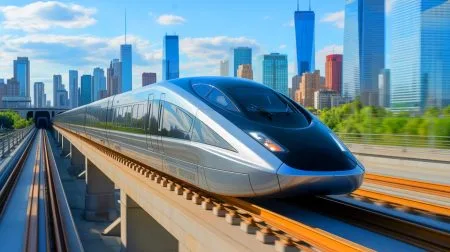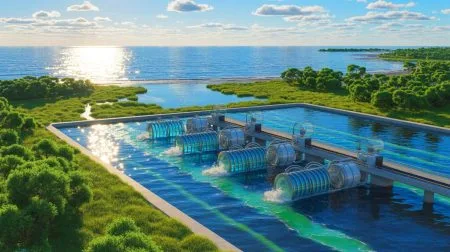| IN A NUTSHELL |
|
Imagine traveling across vast distances at nearly 400 miles per hour on a train that levitates silently above its tracks. This is not a scene from a science fiction novel but a reality in parts of Asia, thanks to magnetic levitation, or maglev, trains. While countries like Japan and China have embraced this technology, the United States and Europe continue to lag behind, struggling even to implement conventional high-speed rail. This disparity raises several questions about technological advancement, cultural priorities, and the future of travel.
From Bullet Trains to Magnetic Levitation
High-speed rail has long been a hallmark of transportation innovation, particularly in Asia. Japan initiated this revolution in 1964 with the Shinkansen bullet trains, setting a precedent for fast, safe, and efficient rail travel. China took this concept further, establishing the world’s largest high-speed rail network. Currently, China accounts for about two-thirds of all global high-speed rail, with trains routinely reaching speeds between 186 and 217 mph.
Building on this success, China introduced magnetic levitation technology with the launch of the Shanghai Maglev line in 2004. Using German technology, this maglev train covers a distance of 18.64 miles in just 7.5 minutes, achieving speeds of up to 268 mph. Meanwhile, Japan continues to develop its own maglev system, the SCMaglev, which set a world record in 2015 by reaching 374 mph. Construction is underway for a line between Tokyo and Nagoya that will drastically reduce travel time, exemplifying Asia’s commitment to advancing rail technology.
The Physics Behind Floating Trains
Maglev trains operate on the principle of magnetism, using powerful electromagnets to lift and propel the train without physical contact with the track. This eliminates rolling resistance, resulting in faster and smoother travel. Two systems dominate maglev technology: Electromagnetic Suspension (EMS) and Electrodynamic Suspension (EDS).
Electromagnetic Suspension (EMS): This system, used in Shanghai’s Transrapid, employs electromagnets under the train to lift it toward a steel track. A small air gap is maintained, with sensors adjusting magnet strength for stability. This allows the train to levitate even when stationary.
Electrodynamic Suspension (EDS): Utilized by Japan’s SCMaglev, EDS involves superconducting magnets cooled to cryogenic temperatures. Initially supported by wheels, the train levitates at higher speeds as repulsive magnetic forces lift it. The track acts as a linear motor, propelling the train forward.
Both systems ensure stability through precise magnet design and control mechanisms, allowing maglev trains to maintain alignment even at extreme speeds.
The Passenger Experience
For passengers, maglev trains offer a unique travel experience. The absence of wheels means a quieter ride, free from the typical clatter and vibration associated with conventional trains. Acceleration is smooth and curves are navigated with ease, with air drag as the only significant resistance.
Maintenance of maglev trains is simpler in some respects. With fewer moving parts like wheels and axles, there are fewer components to wear out and replace. However, the construction of new maglev infrastructure is costly, as existing tracks cannot be retrofitted for maglev technology.
Asia vs. the West: Why the Gap?
The disparity between Asia’s maglev advancements and the West’s struggles is striking. In the United States, projects like the California high-speed rail and the proposed maglev line between Washington, D.C., and Baltimore have faced delays and budget overruns. Similarly, Europe’s high-speed rail projects, such as Britain’s HS2, have encountered financial and logistical challenges.
The reasons for Asia’s lead are multifaceted. China prioritized high-speed rail as a national objective, investing heavily in infrastructure. Japan has consistently funded research and development for decades. Additionally, the dense populations of Asian megacities create high demand for intercity travel, making high-speed rail projects economically feasible.
Cultural and industrial priorities also play a role. China and Japan view high-speed rail as a strategic industry with global export potential. In contrast, the U.S. and parts of Europe rely more on air and road travel, often opting to upgrade existing rail systems rather than invest in new maglev infrastructure.
The Limits of Maglev
Despite its futuristic promise, maglev technology is not without its limitations. The high cost of construction is a significant barrier. Shanghai’s maglev line, for example, was expensive to build and has not been extended due to financial and public concerns. Most of China’s rail network still relies on conventional high-speed trains, which are more cost-effective and flexible.
Japan’s SCMaglev project has also faced delays, partly due to environmental concerns, particularly regarding groundwater. The Tokyo–Nagoya segment is not expected to be operational until at least 2034. Additionally, maglev technology requires entirely new infrastructure, making it a financially daunting prospect for many countries.
Looking ahead, Asia is poised to continue its leadership in maglev technology. China is exploring vacuum tube maglev concepts that could exceed speeds of 600 km/h. Japan aims to extend its SCMaglev line to Osaka. These developments suggest that, by the 2030s, Asian travelers may routinely experience jet-like speeds on the ground. The question remains: Can the West muster the political will and investment to catch up in this race for the future of transportation?
Did you like it? 4.5/5 (21)







Wow, floating trains? Sounds like something out of a sci-fi movie! 🚄
Wow, 400 MPH! 🚄 That’s faster than some planes. When can we expect to see this in the U.S.?